Abstract
Photoionization dynamics of bounded electrons in the ground state, the first and second excited states of a hydrogen atom, triggered by ultrashort near-infrared laser pulses, have been investigated in a transition regime () that offers both multiphoton and tunneling features. Significant differences in spectral characteristics are found between the three low-energy states. The H() ionization probability is larger than the H() value with a special oscillating structure, but both are much greater than the ground state H() in a wide range of laser intensities. By comparing the momentum spectrum and angular distributions of low-energy photoelectrons released from these degenerate states, we find the H() state shows a stronger long-range Coulomb attraction force than the H() state on account of the difference in the initial electron wave packet. Furthermore, analysis of the photoelectron momentum distributions sheds light on both the first and second excited states with a symmetrical intercycle interference structure in a multicycle field but an intracycle interference of an asymmetric left-handed or right-handed rotating spectrum in a few-cycle field. By analyzing photoelectron spectroscopy, we identify the parity characteristics of photoelectrons in different energy intervals and their corresponding above-threshold single-photon ionization (ATSI) or above-threshold double-photon ionization (ATDI) processes. We finally present the momentum distributions of the electrons ionized by laser pulses with different profiles and find the carrier-envelope phase (CEP) is a strong factor in deciding the rotating structure of the emission spectrum, which provides a new method to distinguish the CEP of few-cycle pulses.
1. Introduction
Laser-induced photoionization of the ground state electron is one of the critical effects in strong-field laser–atom interactions. Before the seminal work proposed by Keldysh [1], which gives a standard and broadly accepted model for the description of both multiphoton and tunneling pictures of atomic ionization and offers a reliable tool for the ionization rate calculations, the photoionization process was regarded as a result of direct transitions from the bound electron to free states. In the past several decades, the Keldysh theory has provided a universal framework for analyzing the ionization process in nonlinear ultrafast processes, for instance, high-order harmonic spectroscopy [2,3,4], filamentation of femtosecond laser pulses in a scattering medium [5,6,7], generation of femtosecond electron bunches [8,9] and radiation of terahertz waves [10,11].
Although modern laser technologies have enabled the emergence of ultrashort intense few-cycle pulsed lasers [12,13], allowing electron dynamics studies on an unprecedentedly sophisticated time scale, most of the work in the literature [8,14] of strong-field ionization is both theoretically and experimentally focused on the multiphoton ionization (MPI, ) or tunneling ionization (TI, ) regimes, for example, the electron tunneling time and the position of tunneling exits [15,16], while relatively less focuses on the multiphoton effect of atomic strong-field tunneling dynamics in the transition regime (). In some ways, however, photoionization theories need to explain the details of field-induced ionization dynamics in this key regime and the related investigations are also quite meaningful compared to the enormous number of previous studies. Recent works investigated the signatures of the electron partial-wave distribution [17] and quantitative identification mechanism of MPI and TI for Keldysh parameters close to unity [18], which will surely give rise to more interest in the unexplored phenomena in this intermediate regime.
When hydrogen gas is subjected to an intense laser field, the interaction force with the external electric field can become comparable with that of the Coulomb field. In order to clarify the electron migration behavior, it is necessary to know the diabatic dynamics of electrons in the low-energy states of atomic hydrogen in a transition regime (), though the dynamics of shell electrons in a heavy atomic system such as xenon et al. [19,20,21] and the photoionization of atomic orbital dependence have been studied in the over-barrier regime [22]. In this article, we reveal a comparative study of H(), H() and H() photoexcitation and photoionization dynamics with multiphoton and tunneling characteristics in the above-mentioned transition regime.
The objective of this article is threefold. First, as one cannot consider the dynamics process completely adiabatic at the Keldysh parameter we used, ionization rates for the three bound states should be presented. Hence, we would like to study the multiphoton effects in the electron tunneling process and compare the differences therein. A novel phenomenon of the ionization probability manifesting an oscillating pattern as the laser intensity increases is presented and has been clarified by the channel-closing effect. Second, the photoionization and photoexcitation of bounded states electrons can be affected by the Coulomb force. Although having equal ionization energy a.u.), these L-shell bound states have quite different initial electron wave packet distributions. These differences can result in diverse dynamic behavior in the transition regime, which can be determined by the differential momentum spectroscopy and the angular distributions of low-energy free electrons. Finally, we present that the intercycle and intracycle interference spectrum originating from coherent superposition of free photoelectrons in the adjacent and same optical period can result in symmetrical petal structures and asymmetric left-handed or right-handed rotating structures, respectively. The latter feature can also be adopted in judging the CEP of few-cycle laser pulses.
2. Theoretical Method
In order to discuss the atomic degenerate state ionization processes, we consider the hydrogen in its K-shell and L-shell bound states, interacting with an intense, linear-polarized pulsed laser. The form of time-dependent Schrödinger equation (TDSE) is as follows:
Unperturbed Hamiltonian and the coupling term can be expressed as
and
The form of electromagnetic waves we used is
In numerical calculations, was decomposed on a spherical harmonics basis [23,24,25,26] as
In order to ensure the stable long-time evolution of wave packet propagation, the split-operator method [26] is performed. Finally, we also take advantage of an absorption potential [26,27,28] to avoid the unnecessary wave packet reflection at the boundary. Even so, we still use a wide cut-off radius to keep the electron evolving in enough space so that it can be driven back by the laser field before reaching the boundary. Actually, the size of the outer boundary range and radial grid number are large enough to satisfy convergence. It should be noted that in Equation (5), the expansion can be simplified to only include the partial wave since the influence from is much smaller than the case in the presence of a linearly polarized laser pulse [29]. For a linearly polarized light, the orientation of electrons in space is mainly along the polarization direction, and the components in other extension directions are very small and can be ignored.
Then, the excitation probability of bound states can be estimated by
Therefore, ionization probability of initial states is
In the summation of Equation (7), we include only those states with , where the states beyond contribute little to summation.
Finally, we obtain the photoelectron momentum spectrum by the following formula [30,31]:
where the wave function should be projected onto the continuum state functions once the laser field ends.
3. Results and Discussion
As shown in Figure 1, we firstly investigate the difference in ionization probabilities between the K- and L-shell electrons of hydrogen induced by the pulsed laser with intensities ranging from to W/cm for a 800 nm wavelength, which ranges from a multiphoton to tunneling regime. For this wavelength, the ionization process may be embodied a multiphoton manner since varies from 33 to for K-shell and 16 to for L-shell. Therefore, the multiphoton features for the ionization dynamics in the range of much larger than 1 are presented, where the probability oscillates as a function of the intensity for both the L-shell states. The oscillation pattern with local weak steps and ionization probabilities stays relatively flat before rapidly rising again, which can be attributed to the closing effect of the ionization channel originating from the shifting of the Stark level as the laser intensity increases.
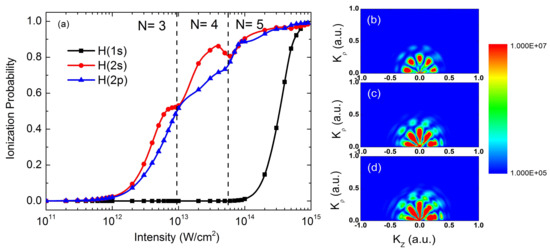
Figure 1.
(Color online) (a) Ionization probability values of the K () shell and L [()] shell electrons of atomic hydrogen exposed to a laser pulse with width of 20 fs as a function of the peak intensity for 800 nm wavelength, solved by TDSE. Two-dimensional (2D) momentum distributions of initial electron under the three peak intensities (b), (c) and W/cm (d), which are around the channel-closing thresholds between and . The channel-closing intensity for absorption of N photons is indicated in (a).
Based on the multiphoton theory, the energy of continuous electrons can be expressed as , where N is the minimum number of photons required for electron ionization, is the ionization potential of the initial state and is the atomic ponderomotive potential under the laser intensity I. It can be inferred that the ATI peak will produce a shift towards the ionization threshold with the increase in light intensity. If the laser intensity exceeds the channel-closing threshold, the lowest order ATI peak would move into the bound energy interval. Thus, ionization probabilities stay relatively flat between two channel-closing thresholds. In the next ionization channel intervals, the ionization probability will continue to increase with the increase in intensity.
This channel-closing effect can also be presented by the low-energy structure of the momentum spectrum, which is shown in the right column of Figure 1. Here, we considered the cases of the state. The peak intensities we used for the three momentum spectra are , and W/cm. For intensity W/cm (Figure 1b), three photons are sufficient to ionize the initial state; thus, the free electrons are dominated by the angular momentum. However, at intensity W/cm (Figure 1c), the former low-energy petal spectrum becomes much weaker, and the higher order ATI peak becomes stronger. Furthermore, once the laser intensity arrives at W/cm, the angular momentum plays a leading role and takes over the original position, meaning that an additional photon is necessary for electron ionization. This process, called channel-closing (or channel-switching), is always accompanied by the oscillating structures of ionization probability. Thus, we can conclude that the multiphoton process still appears even in the tunneling regime.
Furthermore, below ionization saturation intensity W/cm, we observed that the probability values rise in different oscillation trends: in the low-intensity range, the probability values of H() and H() states have faster growth rates than the H() state. Once the intensity exceeds W/cm, this oscillation trend will change, where a rapid growth for the H() state takes place. Moreover, the oscillating of ionization probability versus intensity for both L-shell states with an out-of-phase and the decreasing oscillating amplitude mirrors the multiphoton absorption characteristics in this intensity range. From [32,33], the H() state and the H() state would additionally obtain larger and smaller energy, respectively, when taking the ac-Stark shifting into consideration. Therefore, the transition energy to high-lying excited states differs for the two states, which results in the asynchronous oscillation of ionization probability.
Now, we continue to discuss the origin of diversified oscillation trends of probability values between the three low-energy states. As the ionization potential of L-shell electrons ( a.u.) is much smaller than that of K- shell electrons a.u.), it is easy to understand that H() and H() states have higher ionization probability than the H() state under the same intensity. However, it is more constructive to clarify the difference in ionization probability between L-shell bound states in the same ionization potential.
On one hand, from the point of view of quantum mechanics, the two L-shell bound states have different initial electron wave packets, as shown in Figure 2. In the low-intensity ranges, the photoelectrons mainly appear in the MPI regime where they are affected by a much stronger atomic Coulomb force than in the TI regime, which leads to different behaviors of ionization probability. As can be seen, the electron wave packet of the H() state (Figure 2c) comes closer to the nucleus than the H() state (Figure 2b) and thus the Coulomb focusing effect that the electron experiences is larger for the H() state, which is more obvious in Figure 2d where the radial distribution of the electron wave packet is presented. Moreover, owing to the strong laser pulse used, the interaction of the field acting on the electron is non-perturbative and results in a movement of the electron cloud in the direction of laser polarization. Therefore, the distance between the nucleus and electrons greatly affects the ionization dynamics of the initial states and the radial distribution of the electron wave packet that could be used to describe the ionization potential of atoms [34]. The desired value of the radial scale of the atomic excited state is approximated as [35]:
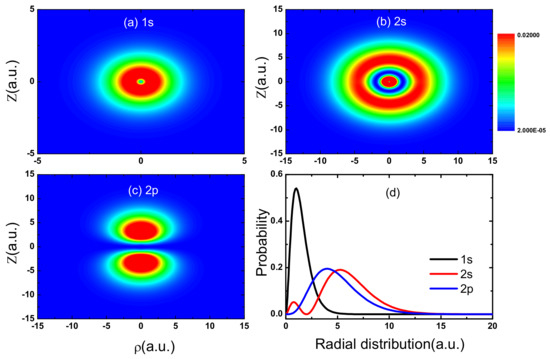
Figure 2.
(Color online) Electron wave packet distribution for H() state (a), H() state (b) and H() state (c). Radial distribution of the three electron eigen wave packets (d).
Under the same principal quantum number n, a smaller l implies a larger , which means a weaker Coulomb force from the nucleus. The probability of ionizing events depends on the competition between the laser-induced spatial displacement and atomic Coulomb force [36,37]. Therefore, the ionizing event is more likely to occur for a smaller l state since it is more susceptible to the external laser pulse. We then come to the conclusion that the electron wave packet diffusion effect reflected in the radial distribution of excited states determines the final photoionization probability, in agreement with the trend of the results in Figure 1.
On the other hand, from the classic point of view, the eccentricity of the bound electron Kepler orbit in the classical trajectory can be expressed as . Thus, the orbital eccentricity will decrease with the increase in l for a specific principal quantum number n. As known from [34,38], the behavior of electrons of excited states exposed to laser fields can be described by a slow motion along the classic orbit accompanied by fast shaking. Therefore, a small l bound electron has a greater ionization probability because it has more opportunities to approach the nucleus. In addition, this mechanism can also be used to reveal the electronic orbital trends of different n states where the ionization rates increase with n monotonically.
The difference in photoionization dynamics owing to the initial electron cloud distribution can also be identified in the final differential momentum spectroscopy and angular distributions of low-energy emission electrons, as shown in Figure 3. From the differential momentum spectra of Figure 3a–c, we identify the differences between the three bound states, particularly the and states. It is obvious that the low-energy momentum spectra show great differences for the three states. The petal structure of the momentum spectrum is usually considered to be the joint effect of atomic Coulomb potential and light field where the free electrons interfere at different ionization exits of the light field, resulting in the emission spectrum [39].
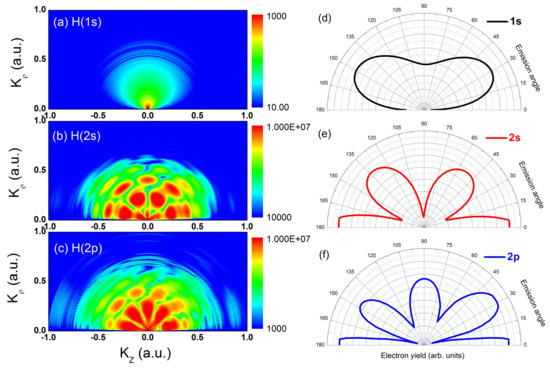
Figure 3.
(Color online) PMDs for hydrogen initial states (a), (b) and (c) calculated by solving the TDSE for a 20 fs pulsed laser with 800 nm at W/cm. Polar plots of the PADs of near-threshold photoelectrons at the same laser parameters with the same initial states (d), (e) and (f), evaluated at kinetic energies corresponding to three-photon ionization of hydrogen via resonant states.
Moreover, both types of shell electrons have different ionization potentials (K-shell, eV and L-shell, eV) and thus the radial jets in the emission spectrum show different division numbers, which are determined by the intensity of the trigger laser and ionization energy of the initial state [40]. It can be observed that the difference in the petal structure decreases significantly for the initial electron from the same shell compared with a different shell’s electron, and it even becomes illegible owing to the complex intercycle free electron orbital interference. In fact, we can also catch sight of the difference in the near-threshold momentum spectrum by making use of the photoelectron angular distributions (PADs). Here the PADs record the photoelectrons emitted in different directions, as shown in Figure 3d–f, which can be used to further study the Coulomb focusing effect at various emission angles for the degenerate L-shell states. Actually, the angular differential spectrum shows obvious jet features that resemble the of degree l, which represents the angular momentum of these electrons [41]. In Figure 3e–f, the two free states are dominated by and , respectively.
Besides the number of side lobes, as can be seen, the three states also differ in the maximum or minimum at as predicted by the emission electron interference effect. The angular distribution of electrons features a minimum or maximum in the perpendicular direction determined by the which is odd or even, where N is the number of photons required for ionization and l is the orbital angular momentum quantum number of the excited state [42,43]. As shown in Figure 3d, at least photons are required to ionize from the initial state , then we can observe a minimum in the direction. Similar and even opposite situations are also presented in Figure 3e,f, where photons are needed for their ionization but with different angular quantum numbers. Moreover, we also observe there are two and three lobes beyond the laser polarization direction for the and state, respectively. These lobes would not change in a certain intensity range of the laser until the channel switching process occurs where the dominant angular momentum and have taken over the near-threshold petal position.
Naturally, the final momentum distribution is dependent on the laser field applied, for example, multicycles of a laser should have different effects from few-cycle pulses. We now inspect how the petaloid modulation structures from the electron interference are expected to vary with the pulse duration. In Figure 4, we present the momentum distribution of the initial , and states of a hydrogen atom with a four-, two- and single-cycle cosine-like pulse of Equation (4).
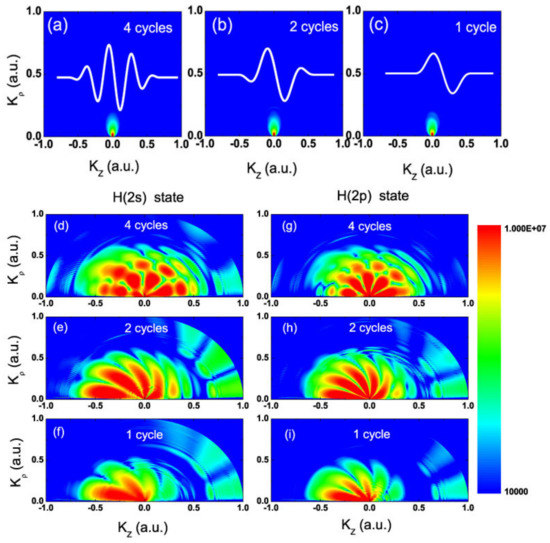
Figure 4.
(Color online) PMDs of initial state (a–c), state (d–f) and state (g–i) of a hydrogen atom exposed to a 800 nm laser. The parameters are the same as in Figure 3 but with different pulse durations.
As the electric field force acting on the state electron is much smaller than the Coulomb attraction force of the nuclear on the K-shell electron, we do not observe an obvious interference structure in Figure 4a–c. We then concentrate on the interference dynamic of L-shell electrons. As can be seen in Figure 4d,g, there exist the common gross features for both states with the approximate symmetric momentum spectrum (around ). The intercycle fringes appearing in positive and negative arise from complex interference between free electrons produced by different pulse periods. This multiphoton effect induces several side lobes and its visibility can change with pulse duration, like the photoelectrons mainly distributed along the oscillating direction of the light field in the few-cycle cases. The electric fields we used are shown in the top row.
In fact, as the laser pulse duration decreases, the emission direction of the photoelectrons experiences a change, thus tending to follow the direction of laser polarization with a rotating structure resulting from the variation in ionization time. For the case of two cycles in Figure 4e,h, we observe an asymmetric momentum distribution with two types: in the region the Ramsauer–Townsend interference fringes can be seen [39,44] where the photoelectrons are mainly generated from the second peak of the light field vector, thus the third peak mainly leads to a rescattering process by controlling the ionized electrons, whereas in the range a series of vertical fringes emerge which originate from the intracycle interference for emission electrons [45]. Similar patterns are presented in Figure 4f,i for a single-cycle pulse. By comparing the two columns we can find an interesting phenomenon that the complex intracycle or intercycle interference spectrum is independent of the initial states in the same shell. It can be expected that few-cycle pulsed lasers with a sine-like wave form will produce similar patterns but with opposite rotating structures.
In order to further explore the characteristics of free electron energy distributions with different initial states, we present the energy spectra with angle-integrated in Figure 5 and it indicates that the photoionization of electrons with a degenerate level () can occur through different pathways which can be categorized as above-threshold single-photon ionization (ATSI) and above-threshold double-photon ionization (ATDI).
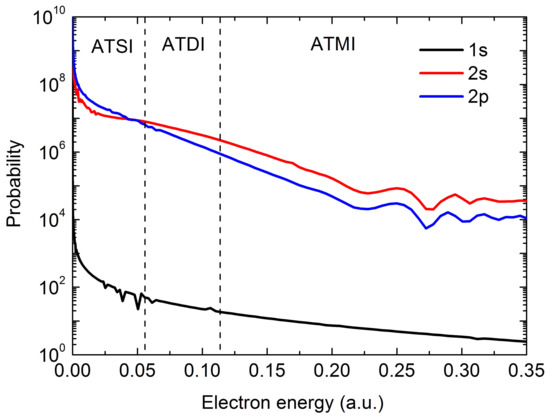
Figure 5.
(Color online) Photoelectron spectroscopy (PES) of different initial states of a hydrogen atom exposed to a 800 nm laser with intensity the same as in Figure 3 but the pulse duration is two cycles (6 fs). Here, ATSI, ATDI and ATMI represent the above-threshold single-photon ionization, above-threshold double-photon ionization and above-threshold multiphoton ionization process, respectively.
As mentioned in the previous paragraph, laser pulses lead to photoionization of L-shell electron wave packets by absorbing three photons and finally arriving at f and g continuum states. In the energy interval a.u. of Figure 5, corresponding to the transient process of two-photon excitation plus single-photon ionization, the ionization yield of electrons is slightly greater than that of electrons, which means ATSI is dominant below the first ATI peak for odd-parity initial states. However, once the photoelectron energy exceeds the interval a.u., the ionization pathway is shown to drastically change the dynamic feature of the wave packet into the g continuum state via f continuum state electrons, opening an ATDI (and above-threshold multiphoton ionization, ATMI) channel that dominates over the ATSI. It is intuitively shown in Figure 6. Moreover, there are no obvious ATI peaks in Figure 5. That is because the occurrence of ATI peaks is related to the periodic interference between different laser pulses and here the pulse duration we used (2 cycles) is too short to cause periodic interference. Actually, if we utilized a multicycle (greater than six cycles) laser pulse, an abundant structure of ATI peaks would be presented.
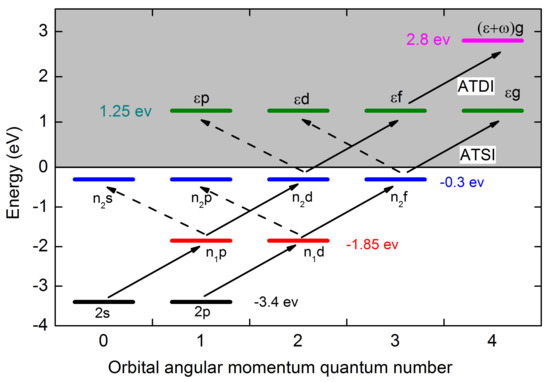
Figure 6.
(Color online) Schematic of the resonance coupling between the L-shell electrons and a series of Rydberg states or free electrons. Each diagonal arrow represents a photon absorption of approximately eV in energy. Two possible quantum paths are shown to produce free electrons by photon absorption.
Fine substructures of PES are often related to the multiphoton resonantly enhanced ionization effect. Figure 6 shows the resonant scheme of hydrogen based on bound and continuous energy levels for the two excited states. For different wavelengths, multiple transition paths are available during the laser pulse acting on the initial L-shell electron. Here, we should note the feasibility of the dipolar selection rule in high-field multiphoton ionization processes [41]. When the orbital quantum number of a particular free electron state is l and it absorbs one more photon, the parity of the photoelectron will change and its angular momentum will be since the transition matrix element from l to is much larger than [29]. Therefore, for an 800 nm pulsed laser there are two resonantly enhanced multiphoton ionization pathways: (i) ionization process via two-photon resonant transition , subsequently leading to free electrons with f- and g-symmetry, and (ii) ionization process via two-photon excitation of states, giving rise to photoelectrons with g-symmetry. They correspond to the ATDI and ATSI peaks in Figure 5, respectively.
Figure 7 displays the momentum spectra of free electrons ionized from the H() state. The spectra recorded at (a) , (b) , (c) , (d) are shown for ±sine-like and ±cosine-like pulses as defined in the insets. A clear interference spectrum can be seen with different visibility. An obvious feature in presenting such spectra is that their rotation structure changes in the wake of the variable carrier phase. In Figure 7a, corresponding to the 0-phase cosine pulses, the emission spectrum exhibits a clear left-handed roll structure. Changing the pulse phase by interchanges the left-handed or right-handed structures in Figure 7c.
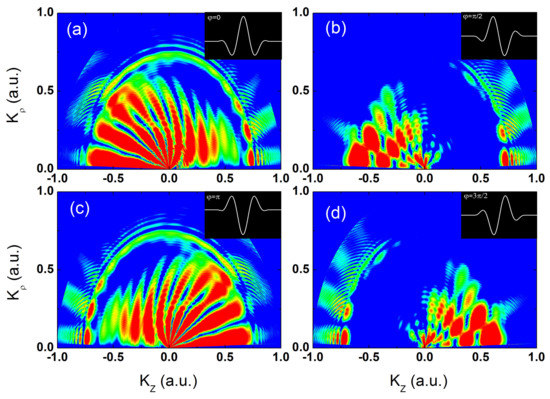
Figure 7.
(Color online) Photoelectron momentum spectra of H() state ionized by 6 fs pulsed laser with the intensity W/cm in the wake of carrier phase: (a) , (b) , (c) , (d) . Insets display the profiles for ±sine-like and ±cosine-like pulsed laser. For cosine pulses the fringes exhibit a left-handed roll structure for electron emission under the 0-phase field while in the opposite phase a right-handed roll structure is observed.
Moreover, the high visibility can be seen for ±cosine-like pulses but the visibility is low for the ±sine-like case where the roll structure is eliminated in a special momentum interval. A straightforward explanation is detailed by the following model. For the +cosine-like pulse case (Figure 7a), there are two wave crests in the negative direction and just one crest in the positive direction (shown in the inset). As the momentum spectra are formed by free electron interference at different ionization exits (here corresponding to the two crests), we observe the high visibility roll structure in the interval of . The interference pattern does not completely disappear in the interval of , which is caused by the interference between the free electron triggered by the single crest in the positive direction and other electrons, although this interference is too weak to create a high visibility roll structure. In Figure 7b,d, two roll structures of weaker visibility are observed compared with that in Figure 7a,c. These structures result from the low interference probability of the free electron for ±sine-like pulses where the electric field vector only has a single crest in the positive or negative direction. Experimentally, if a pair of alternate laser fields (both +sine-like and −sine-like pulses) are applied (in Figure 8a), we can obtain a symmetric high-visibility roll structure in the entire momentum space as shown in Figure 8b.
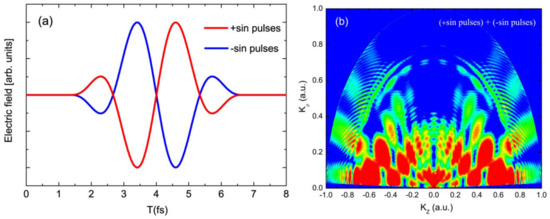
Figure 8.
(Color online) (a) Temporal variation of the electric field of few-cycle pulsed laser with phase (“-sinelike”, blue line) and (“+sinelike”, red line). (b) The photoelectron momentum spectrum of H() state ionized by an alternate field with the same laser parameters but with carrier phase and .
Therefore, this phase-dependent left-handed or right-handed rotation spectrum provides a new method to distinguish the CEP in a few-cycle pulsed laser and image the launch path of excited-state electrons. In fact, utilizing the phase-controlled ultrashort pulsed laser, the control of pulse temporal evolution, the closing or opening of ionization exits and manipulating the distribution of the electron momentum can also be achieved.
4. Conclusions
In brief, we have studied the laser-induced ionization dynamics of hydrogen atom degenerate states in the special Keldysh parameter transition regime. A near-infrared ultrashort intense laser field is introduced to study the ionization rates of the K-shell electron theoretically, and is also extended to the similar process for the L-shell electrons of hydrogen where the ATI electron results in the rich emission spectrum structure in momentum space. The oscillation structure of ionization probabilities was reasonably explained by the closing effect of the ionization channel. Besides presenting the petaloid pattern originating from temporally separated wave packet interference in the energy domain, we have also identified the differences in the momentum features near the threshold and in photoelectron angular distribution between the three low-energy bound states. In the momentum distribution of both the L-shell bound states, there exists a similar phenomenon of the intercycle and intracycle interference effect resulting from the free electron interference. A characteristic feature in the PES is that photoelectrons carry different dominant parities in different energy regions. The resonant coupling between electron energy levels and photons shows that photoelectrons with g-symmetry for the initial H() bound state are more dominant than those in the H() bound state in the ATSI region but photoelectrons triggered from the initial state dominate in the ATDI region, which have been reasonably explained by the unidirectional dipole transition selection rule. Finally, we also investigated the CEP dependence of photoelectron momentum spectroscopy and showed that the roll structure asymmetry occurring on left or right sides is related to the interference among emission electrons in different ionization outlets. That means that manipulating the migration of excited states, tracing the state-coupling information and controlling the evolution process of degenerate low-energy states can be achieved by controlling the pulse phase of few-cycle optical fields.
Author Contributions
Conceptualization, P.X.; methodology, P.X. and T.Q.; validation, P.X. and H.M.; writing—original draft preparation, P.X.; writing—review and editing, T.Q., H.M. and H.Y.; visualization, H.L.; supervision, H.Y. and H.L.; funding acquisition, P.X., T.Q. and H.L. All authors have read and agreed to the published version of the manuscript.
Funding
The work was supported by the Natural Foundation of Shandong Province (No. ZR2021QA045, ZR2021LLZ001), Anhui Province Key Laboratory of Optoelectric Materials Science and Technology (No. OMST202103), National Natural Science Foundation of China (No. 12074388).
Institutional Review Board Statement
Not applicable.
Informed Consent Statement
Not applicable.
Data Availability Statement
Not applicable.
Conflicts of Interest
The authors declare no conflict of interest.
References
- Keldysh, L.V. Ionization in the field of a strong electromagneticwave. Sov. Phys. JETP 1965, 20, 1037. [Google Scholar]
- Popmintchev, T.; Chen, M.-C.; Popmintchev, D.; Arpin, P.; Brown, S.; Alisauskas, S.; Andriukaitis, G.; Balciunas, T.; Mucke, O.D.; Pugzlys, A.; et al. Bright coherent ultrahigh harmonics in the kev X-ray regime from mid-infrared femtosecond lasers. Science 2012, 336, C1287–C1291. [Google Scholar] [CrossRef] [PubMed]
- L’Huillier, A.; Balcou, P. High-order harmonic generation in rare gases with a 1-ps 1053-nm laser. Phys. Rev. Lett. 1993, 70, 774. [Google Scholar] [CrossRef] [PubMed]
- Lewenstein, M.; Balcou, P.; Ivanov, M.Y.; L’Huillier, A.; Corkum, P.B. Theory of high-harmonic generation by low-frequency laser fields. Phys. Rev. A 1994, 49, 2117. [Google Scholar] [CrossRef]
- Chin, S.L.; Xu, H. Tunnel ionization, population trapping, filamentation and applications. J. Phys. B 2016, 49, 222003. [Google Scholar] [CrossRef]
- Béjot, P.; Kasparian, J.; Henin, S.; Loriot, V.; Vieillard, T.; Hertz, E.; Faucher, O.; Lavorel, B.; Wolf, J.P. Higher-order kerr terms allow ionization-free filamentation in gases. Phys. Rev. Lett. 2010, 104, 103903. [Google Scholar] [CrossRef] [Green Version]
- Couairon, A.; Mysyrowicz, A. Femtosecond filamentation in transparent media. Phys. Rep. 2007, 441, 47–189. [Google Scholar] [CrossRef]
- Becker, W.; Liu, X.; Ho, P.J.; Eberly, J.H. Theories of photoelectron correlation in laser-driven multiple atomic ionization. Rev. Mod. Phys. 2012, 84, 1011. [Google Scholar] [CrossRef]
- Quan, W.; Hao, X.; Hu, X.; Sun, R.; Wang, Y.; Chen, Y.; Yu, S.; Xu, S.; Xiao, Z.; Lai, X.; et al. Laser-induced inelastic diffraction from strong-field double ionization. Phys. Rev. Lett. 2017, 119, 243203. [Google Scholar] [CrossRef]
- Kim, K.Y.; Taylor, A.J.; Glownia, J.H.; Rodriguez, G. Coherent control of terahertz supercontinuum generation in ultrafast laser–gas interactions. Nat. Photonics 2008, 2, 605–609. [Google Scholar] [CrossRef]
- Kim, K.Y.; Glownia, J.H.; Taylor, A.J.; Rodriguez, G. Terahertz emission from ultrafast ionizing air in symmetry-broken laser fields. Opt. Express 2007, 15, 4577. [Google Scholar] [CrossRef]
- Corkum, P.B.; Krausz, F. Attosecond science. Nat. Phys. 2007, 3, 381. [Google Scholar] [CrossRef]
- Wirth, A.; Hassan, M.T.; Grguras, I.; Gagnon, J.; Moulet, A.; Luu, T.T.; Pabst, S.; Santra, R.; Alahmed, Z.A.; Azzeer, A.M.; et al. Synthesized light transients. Science 2011, 334, C195–C200. [Google Scholar] [CrossRef] [Green Version]
- Krausz, F.; Ivanov, M. Attosecond physics. Rev. Mod. Phys. 2009, 81, 163. [Google Scholar] [CrossRef] [Green Version]
- Eckle, P.; Pfeiffer, A.N.; Cirelli, C.; Staudte, A.; Dorner, R.; Muller, H.G.; Buttiker, M.; Keller, U. Attosecond ionization and tunneling delay time measurements in helium. Science 2008, 322, 1525. [Google Scholar] [CrossRef]
- Pfeiffer, A.N.; Cirelli, C.; Smolarski, M.; Dimitrovski, D.; Abu-samha, M.; Madsen, L.B.; Ursula, K. Attoclock reveals natural coordinates of the laser-induced tunnelling current flow in atoms. Nat. Phys. 2011, 8, 76. [Google Scholar] [CrossRef] [Green Version]
- Arbó, D.G.; Lemell, C.; Burgdörfer, J. Signatures of tunneling and multiphoton ionization by short-laser pulses: The partial-wave distribution. J. Phys. Conf. Ser. 2015, 635, 012007. [Google Scholar] [CrossRef]
- Wang, R.; Zhang, Q.; Li, D.; Xu, S.; Cao, P.; Zhou, Y.; Cao, W.; Lu, P. Identification of tunneling and multiphoton ionization in intermediate keldysh parameter regime. Opt. Express 2019, 27, 6471. [Google Scholar] [CrossRef]
- Fukuzawa, H. Deep Inner-Shell Multiphoton Ionization by Intense X-ray Free-Electron Laser Pulses. Phys. Rev. Lett. 2013, 110, 173005. [Google Scholar] [CrossRef]
- Richardson, V.; Costello, J.T.; Cubaynes, D.; Düsterer, S.; Feldhaus, J.; van der Hart, H.W.; Juranić, P.; Li, W.B.; Meyer, M.; Richter, M.; et al. Two-Photon Inner-Shell Ionization in the Extreme Ultraviolet. Phys. Rev. Lett. 2010, 105, 013001. [Google Scholar] [CrossRef] [Green Version]
- Rey, H.F.; van der Hart, H.W. Multiphoton inner-shell ionization of the carbon atom. Phys. Rev. A 2015, 92, 013417. [Google Scholar] [CrossRef] [Green Version]
- Song, S.-N.; Geng, J.-W.; Jiang, H.-B.; Peng, L.-Y. Comparative study of H(2s)and H(2p0)ionization dynamics in the over-barrier regime. Phys. Rev. A 2014, 89, 053411. [Google Scholar] [CrossRef]
- Light, J.C.; Walker, R.B. An R matrix approach to the solution of coupled equations for atom-Cmolecule reactive scattering. J. Chem. Phys. 1976, 65, 4272. [Google Scholar] [CrossRef]
- Dickinson, A.S.; Certain, P.R. Calculation of matrix elements for one-dimensional quantum-mechanical problems. J. Chem. Phys. 1968, 49, 4209. [Google Scholar] [CrossRef]
- Harris, D.O.; Engerholm, G.G.; Gwinn, W.D. Calculation of matrix elements for one-dimensional quantummechanical problems and the application to anharmonic oscillators. J. Chem. Phys. 1965, 43, 1515. [Google Scholar] [CrossRef] [Green Version]
- Tong, X.-M.; Chu, S.-I. Theoretical intense study of multiple high-order harmonic generation by ultrashort pulsed laser fields: A new generalized pseudospectral time-dependent method. Chem. Phys. 1997, 217, 119. [Google Scholar] [CrossRef]
- Krause, J.L.; Schafer, K.J.; Kulander, K.C. Calculation of photoemission from atoms subject to intense laser fields. Phys. Rev. A 1992, 45, 4998. [Google Scholar] [CrossRef]
- Jiang, T.F.; Chu, S.I. High-order harmonic generation in atomic hydrogen at 248 nm: Dipole-moment versus acceleration spectrum. Phys. Rev. A 1992, 46, 7322. [Google Scholar] [CrossRef] [Green Version]
- Chen, Z.; Morishita, T.; Le, A.-T.; Wickenhauser, M.; Tong, X.M.; Lin, C.D. Analysis of two-dimensional photoelectron momentum spectra and the effect of the long-range coulomb potential in single ionization of atoms by intense lasers. Phys. Rev. A 2006, 74, 053405. [Google Scholar] [CrossRef] [Green Version]
- Dionissopoulou, S.; Mercouris, T.; Lyras, A.; Nicolaides, C.A. Strong laser-field effects in hydrogen: High-order above-threshold ionization and photoelectron angular distributions. Phys. Rev. A 1997, 55, 4397. [Google Scholar] [CrossRef]
- Schöller, O.; Briggs, J.S.; Dreizler, R.M. Coherent excitation of hydrogen atoms by proton impact. J. Phys. B 1986, 19, 2505. [Google Scholar] [CrossRef]
- Delone, N.B.; Krainov, V.P. Ac stark shift of atomic energy levels. Phys. Usp. 1999, 42, 669. [Google Scholar] [CrossRef]
- Rottke, H.; Wolff-Rottke, B.; Feldmann, D.; Welge, K.H.; Dörr, M.; Potvliege, R.M.; Shakeshaf, R. Atomic hydrogen in a strong optical radiation field. Phys. Rev. A 1994, 49, 4837. [Google Scholar] [CrossRef]
- Benvenuto, F.; Casati, G.; Shepelyansky, D.L. Stability of rydberg atoms in a strong laser field. Phys. Rev. A 1992, 45, R7670. [Google Scholar] [CrossRef]
- Gallagher, T.F. Rydberg Atom Wavefunctions. In Rydberg Atoms; Dalgarno, A., Knight, P.L., Read, F.H., Zare, R.N., Eds.; Cambridge University Press: Cambridge, UK, 1994; pp. 10–26. [Google Scholar]
- Ivanov, I.A.; Kheifets, A.S.; Bartschat, K.; Emmons, J.; Buczek, S.M.; Gryzlova, E.V.; Grum-Grzhimailo, A.N. Displacement effect in strong-field atomic ionization by an xuv pulse. Phys. Rev. A 2014, 90, 043401. [Google Scholar] [CrossRef] [Green Version]
- Xiao, X.-R.; Wang, M.-X.; Liang, H.; Gong, Q.; Peng, L.-Y. Proposal for measuring electron displacement induced by a short laser pulse. Phys. Rev. Lett. 2019, 122, 053201. [Google Scholar] [CrossRef]
- Xin, P.; Cheng, H.; Zhang, S.; Wang, H.; Liu, H. Wavepacket dynamics of rydberg atom monitored by a pair of time-delayed laser pulses. J. Phy. B 2018, 51, 045601. [Google Scholar] [CrossRef]
- Arbö, D.G.; Yoshida, S.; Persson, E.; Dimitriou, K.I.; Burgdxoxrfer, J. Interference oscillations in the angular distribution of laser-ionized electrons near ionization threshold. Phys. Rev. Lett. 2006, 96, 143003. [Google Scholar] [CrossRef]
- Arbö, D.G.; Miraglia, J.E.; Gravielle, M.S.; Schiessl, K.; Persson, E.; Burgdxoxrfer, J. Coulomb–Volkov approximation for near-threshold ionization by short laser pulses. Phys. Rev. A 2008, 77, 013401. [Google Scholar] [CrossRef] [Green Version]
- Li, M.; Liu, Y.; Liu, H.; Yang, Y.; Yuan, J.; Liu, X.; Deng, Y.; Wu, C.; Gong, Q. Photoelectron angular distributions of low-order above-threshold ionization of Xe in the multiphoton regime. Phys. Rev. A 2012, 85, 013414. [Google Scholar] [CrossRef]
- Krajewska, K.; Fabrikant, I.I.; Starace, A.F. Threshold effects in strong-field detachment ofhandf: Plateau enhancements and angular distribution variations. Phys. Rev. A 2006, 74, 053407. [Google Scholar] [CrossRef]
- Gribakin, G.F.; Kuchiev, M.Y. Multiphoton detachment of electrons from negative ions. Phys. Rev. A 1997, 55, 3760. [Google Scholar] [CrossRef] [Green Version]
- Arbö, D.G.; Dimitriou, K.I.; Persson, E.; Burgdxoxrfer, J. Sub-poissonian angular momentum distribution near threshold in atomic ionization by short laser pulses. Phys. Rev. A 2008, 78, 013406. [Google Scholar] [CrossRef]
- Arbö, D.G.; Ishikawa, K.L.; Persson, E.; Burgdxoxrfer, J. Doubly differential diffraction at a time grating in above-threshold ionization: Intracycle and intercycle interferences. Nucl. Instruments Methods Phys. Res. Sect. B 2012, 279, 24–30. [Google Scholar] [CrossRef]
Publisher’s Note: MDPI stays neutral with regard to jurisdictional claims in published maps and institutional affiliations. |
© 2022 by the authors. Licensee MDPI, Basel, Switzerland. This article is an open access article distributed under the terms and conditions of the Creative Commons Attribution (CC BY) license (https://creativecommons.org/licenses/by/4.0/).